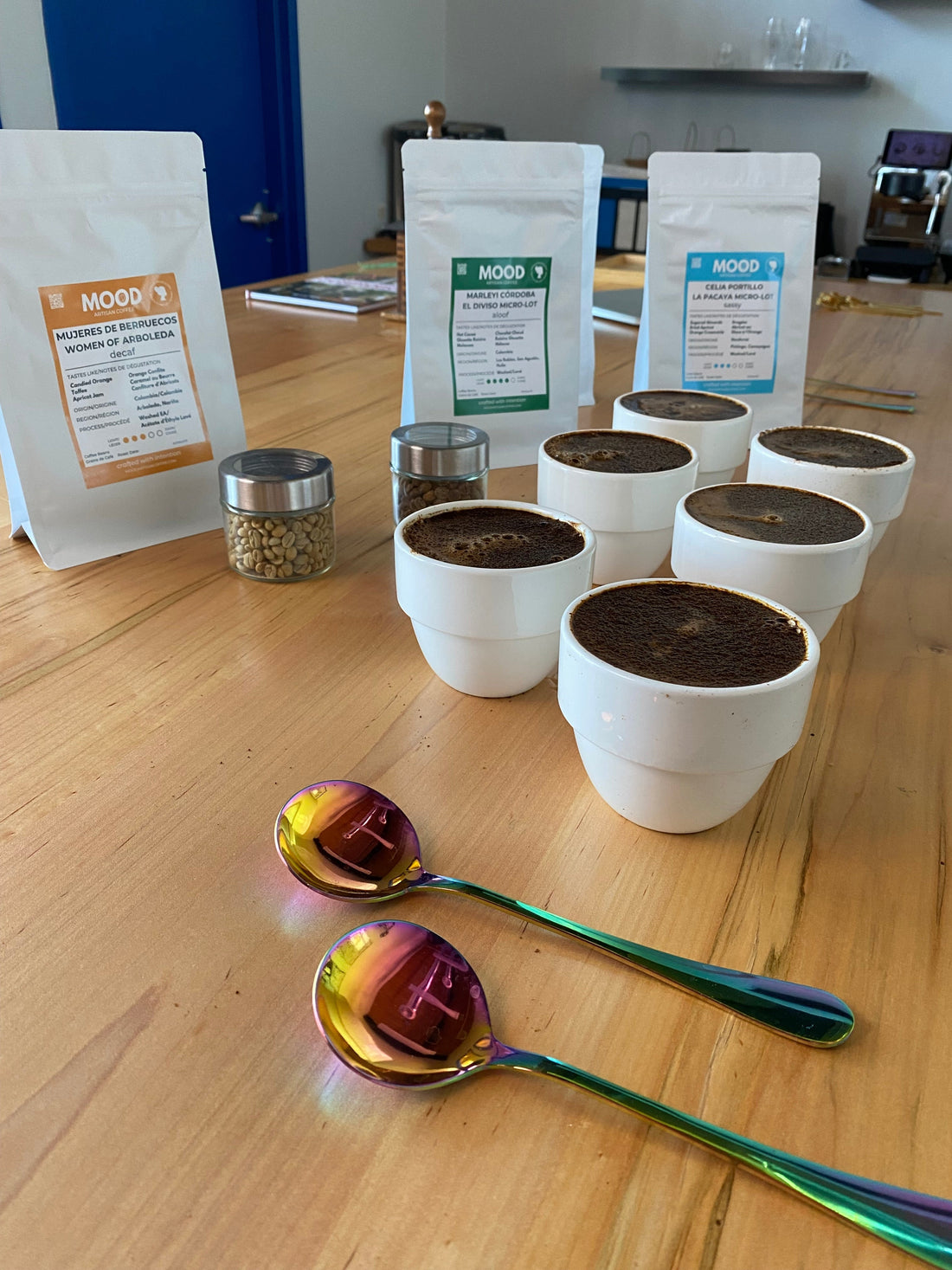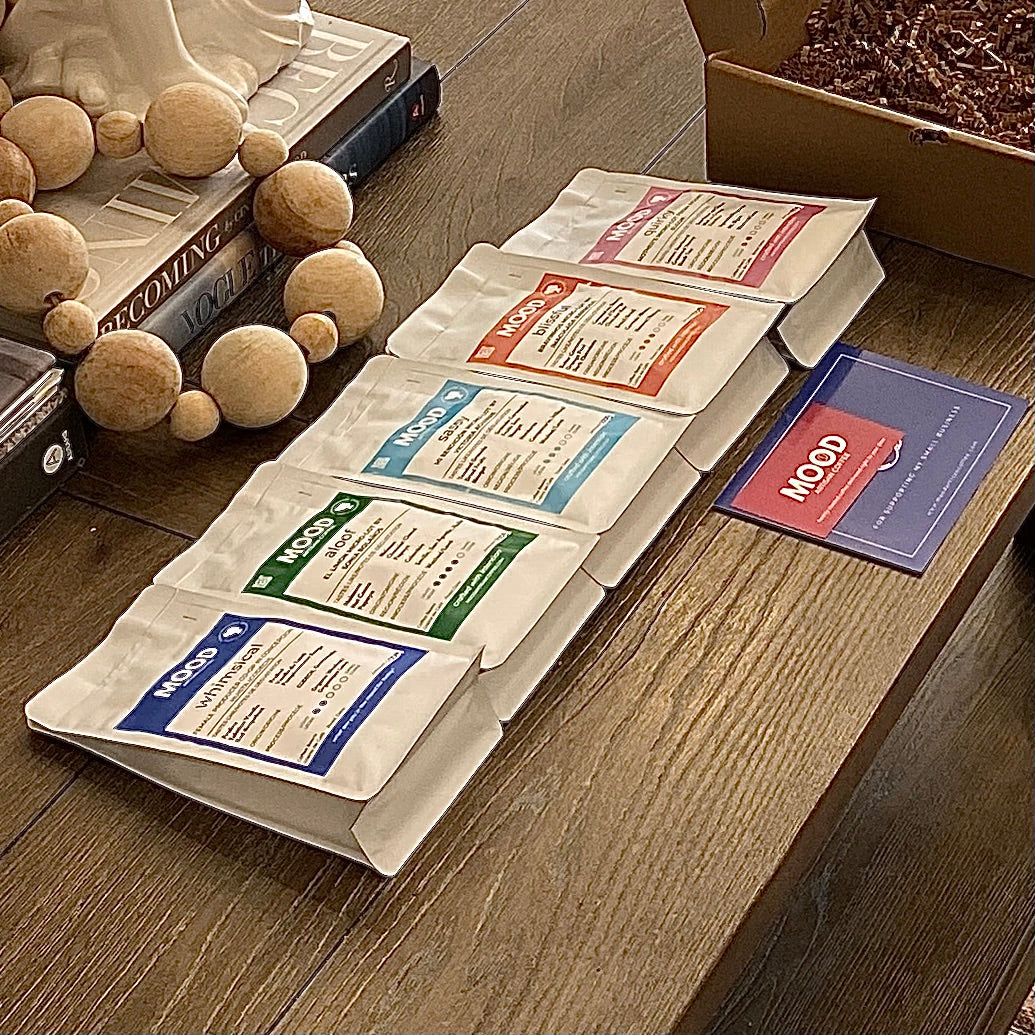
Coffee Myths, Debunked: What Really Makes a Great Cup
Share
Every coffee drinker has heard the claims.
“Dark roast means more caffeine.”
"Light roast means more caffeine."
“Strong coffee means it's a dark roast”
Here’s the truth: most of what people believe about coffee is marketing, not science.
At Mood Artisan Coffee, we love making specialty coffee approachable.
So, let’s set the record straight on what actually matters when it comes to brewing a truly great cup.
Myth #1: Dark Roast = Stronger Coffee
Let’s start with the most common myth in coffee. Somewhere along the line, people started equating dark roast with stronger coffee, but the two have nothing to do with each other.
Roast level affects the flavour spectrum (sours and bitters), not caffeine.
In fact, dark roasts usually have slightly less caffeine than lighter ones because roasting breaks down caffeine molecules over time. But that difference is tiny. The real change is in taste.
Dark roasts develop deeper, bolder flavours like chocolate, smoke, and molasses because the beans are roasted longer. Lighter roasts highlight more nuanced fruit, floral, or citrus notes that reflect the bean’s origin. This isn't a catch all however (the bean origin and processing has a lot to do with end flavour as well!).
The truth: Strength comes from how much coffee you brew relative to water, not how dark the roast is.
If you like bold flavour, try using a bit more coffee per cup but don’t assume darker equals better. At Mood, we roast intentionally to bring balance, not bitterness. Whether you love the chocolatey depth of Aloof or the bright complexity of Nostalgia, the goal is always flavour clarity, not harshness.
Myth #2: “Strong Coffee” Means Better Coffee
When someone says they like their coffee “strong,” what they usually mean is they want it flavourful. But strength and flavour aren’t the same.
Strength comes from brew ratio and/or grind size.
Flavour comes from the bean’s quality, freshness, and how it’s roasted and brewed.
Over-extracted coffee (too strong, too long, or too fine a grind) can taste bitter and burnt.
Under-extracted coffee (too weak, too short, or too coarse) can taste sour, astringent and thin.
The best coffee balances sweetness, acidity, and body: that smooth, rounded experience where every sip tastes intentional.
If you want to make your cup “stronger,” increase your brew ratio gradually (add a little bit more coffee each time).
Alternatively, you can grind a bit finer but I don’t recommend starting there, especially if you’re brewing espresso. Every time you adjust your grind size, your grinder retains a small amount of the previous grind. This is called grinder retention, and it means the first few grams after any adjustment aren’t truly representative of your new setting.
To get consistency, you’d need to purge (grind and discard) those retained grounds each time you make a change, which leads to waste. Skip the purge, and you’ll end up chasing inconsistent shots that never taste quite right. Conclusion: try changing dose first prior to grind size!
Myth #3: Freshness Doesn’t Matter Once It’s Sealed
I get it. Grocery store coffee with a “best before” date two years away looks convenient. But coffee isn’t like wine. It doesn’t improve with age.
Coffee is a fresh product, just like bread or produce. Once roasted, its natural oils and aromatics start to break down within weeks.
Although certain coffees do sometimes benefit from a bit of "aging", I'd never recommend consuming coffee more than ~6 months old.
Even with fancy packaging, most grocery store coffees have already aged months before they reach your kitchen. That’s why they taste flat and stale, even when “sealed.”
At Mood, every coffee is roasted in small batches and shipped fresh so you’re tasting the beans at their peak. You’ll notice it immediately: the aroma bursts open when you grind it, and the flavour feels alive in your cup.
Pro tip: Look for a “roast date,” not a “best before date.” That’s how you know you’re getting real freshness.
Myth #4: Espresso Beans Are Different From Regular Beans
Here’s a fun secret: “espresso beans” don’t actually exist!
Espresso is a brewing method, not a type of bean.
The label “espresso” usually means the coffee was roasted and/or blended with espresso in mind, meaning it’s designed to taste balanced and rich under pressure. But you can technically use any coffee bean for espresso or filter brewing.
In fact, many of Mood’s coffees shine across both.
So, don’t limit yourself. Brew how you love to brew. What matters most is how fresh and well-roasted the coffee is, not what the bag says.
Myth #5: You Need Expensive Equipment to Make Great Coffee
Another myth that keeps people from exploring specialty coffee is the idea that you need to spend hundreds (or thousands) on fancy gear.
Sure, a precision grinder and a gooseneck kettle make brewing easier, but great coffee starts with great beans, a few inexpensive tools and attention.
If you buy freshly roasted coffee, weigh out each dose, grind it just before brewing, and pay attention to your ratios and water temperature, you’re already 90% of the way there.
You can make an exceptional cup with a French press, Aeropress, or even a basic drip machine. Consistency and intention always beat equipment.
Many people who are thinking of splurging on an espresso machine have asked me for recommendations. What do I tell them? Buy a cheaper espresso machine (without a built in grinder) and spend more of your budget on getting a good quality burr grinder.
So, What Really Makes a Great Cup?
Forget the buzzwords. Great coffee comes down to three things:
- Quality beans: sourced with care, roasted fresh, and traceable back to the farmers who grow them.
- Proper brewing: the right ratio, grind, and time.
- Intention: slowing down to actually taste what’s in your cup.
That’s the foundation of everything we do at Mood Artisan Coffee.
We don’t roast for trends or intensity. We roast for clarity, sweetness, and connection.

4 comments
Thank you, Janis! Glad you found it helpful!!
@kevin – such great insight and what a great coffee journey! I love hearing that a quality burr grinder and scale have made a difference for you and experimenting with dose (input) helped bring out the coffee’s natural (inherent) flavours. Who says we can’t make great coffee at home?! This is awesome!!
Excellent post. It mirrors my own coffee journey. I started out enjoying dark roasts, as I thought that was how coffee was supposed to taste. I now go for medium and light roasts, as they highlight flavour notes that dark roasts tend to mask. I also found out that I was brewing my coffee too strong. I would have a beautiful pour over at a coffee shop, but was unable to replicate the results at home. My ratio of coffee-to-water was completely off. My remedy was to purchase a coffee scale. I incrementally dialed back the ratio just right. Investing in a coffee scale and a quality burr grinder have been key for me to brew excellent coffee at home.
Great article
Thank you, Seema